There are only 2 present species and one genus in the family of Promeropidae. The sugarbirds make up a small genus, Promerops, of passerine birds which are restricted to southern Africa. They have brownish plumage, the long downcurved bill typical of passerine nectar feeders, and long tail feathers.
The Gurney's Sugarbird is found from Zimbabwe southwards, except the extreme south of South Africa, where it is replaced by the Cape Sugarbird in the Cape provinces of South Africa. It has at times been considered conspecific with Gurney's. The distribution of the Gurney's Sugarbird is disjunct, and currently there are two accepted subspecies, one in the north and one further south.
Sugarbirds are dependent on Protea and are found in protea scrub. The Cape Sugarbird is found in Fynbos and has also moved into gardens and nurseries.
The two sugarbird species are medium sized passerines that are 23–44 cm in length. Between to 15–38 cm of that length is in their massive elongated tails, with the tails of the Cape Sugarbird being overall longer than those of the Gurney's Sugarbird. In both species the tail of the male is longer than the female, although the difference is more pronounced in the Cape Sugarbird. In overall body size the males are slightly larger and heavier than the females. Both species have long and slender bills that are slightly curved, and again the females have a slightly shorter bill, leading to differences in feeding niches. The skull and tongue morphology of the sugarbirds is very similar to that of the honeyeaters, the result of convergent evolution. The tongue is long and protrusible, and is tubular and frilled at the end.
Nectar from the inflorescences of the Protea provide most of the energy these species require, and they are considered significant pollinators of the genus. The birds' diet is supplemented by insects attracted to the inflorescences. Studies of the diets of sugarbirds found that bees in the family Apidae and flies formed a large part of the diet and that the insects were obtained by hawking.
Sugarbirds are monogamous, and male sugarbirds defend territories during the breeding season. Females lay two eggs in a nest in a fork of a tree.
Africa Wild Bird Book
Family Promeropidae (Sugarbirds) Index
Family Promeropidae (Sugarbirds)
Promerops cafer Cape Sugarbird 773
Promerops gurneyi Gurney's Sugarbird 774
Promerops cafer Cape Sugarbird 773
Promerops gurneyi Gurney's Sugarbird 774
Cape Sugarbird
773. Cape Sugarbird Promerops cafer (Kaapse Suikervoël)
Order: Passeriformes. Family: Promeropidae
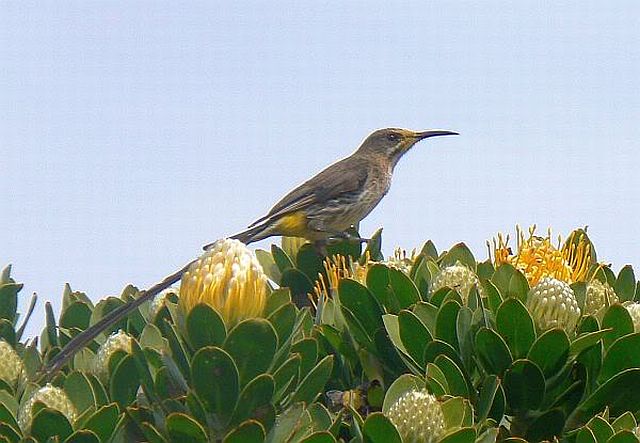
Description
A brown bird with very long tail and long, curved bill. It is usually associated with Proteas. Size 25-29 cm (female) 34-44 cm (male). It is easily recognisable by a spot of yellow under its tail and the very long tail feathers present in males.
Adult: Forehead straw-coloured, indistinctly streaked blackish. Crown blackish brown, feathers edged buff; nape blackish brown. Lores and ear coverts brownish. Malar stripe brown, bordered above by white stripe. Hind neck to mantle brown, blotched blackish. Back olive-brown, with diffuse black streaking. Rump and upper tail coverts yellowish olive green. Tail greyish, blackening distally. Upper wing coverts brown, narrowly edged olive; flight feathers dark brown above, shiny greyish brown below. Underwing coverts brown. Chin and throat white to off-white. Upper and mid-breast brown, feather tips buffy, crescent-shaped. Lower breast and belly whitish or greyish white, with bold black and brown streaking, densest on sides. Flanks buff, heavily streaked dark brown. Undertail coverts bright yellow. Bill black. Eyes dark brown. Legs and feet black.
Females are shorter-tailed, shorter-billed, and paler breasted. Top of the head brown. White chin with a brown stripe and a white line above it. Pale underparts - the female with a white chest centre and belly. Flanks and lower belly streaked. The male’s tail is very long (1.5 times body length or more) and the female’s tail is about the length of the body.
Another characteristic of the Cape Sugarbird is the sound it makes when it flies. The main flight feathers are arranged in such a way that when the bird beats its wings, a frrt-frrt sound is made with the intention of attracting females.
Distribution
Western Cape (common) extending into the Eastern Cape.
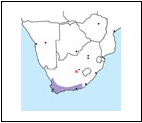
Habitat
Restricted to the Cape Fynbos, as it is highly dependent on Protea's for nectar and nesting sites.
Diet
Nectar of protea (mainly Leucospermum and Mimetes) insects, spiders.
Breeding
A monogamous solitary nester, the male vigorously defends his territory against other males and predatory species, such as Common fiscal and Southern boubou. The nest is built solely by the female in about 5-10 days, first gathering dead Erica leaves, bracken and dry grass and then moulding them with its body into a cup shape. The outside of the structure is reinforced with stems of plants such as restios, serrurias (Serruria) and everlastings (Helichrysum), while the interior is lined with grass and brown fluff from Protea flowers. It is typically placed in the foliage of a bush, especially Protea but also other genera. Egg-laying is season mainly from March-August, peaking from March-June, coinciding with the flowering of proteas. It lays 1-2 eggs, which are incubated solely by the female for about 12-20 days, defending against predators by performing a distraction display in which it drops to the ground with drooping wings like it has been injured. The young chicks are brooded solely by the female but fed by both adults on a diet of nectar, although once they got older they are more commonly fed on insects. They eventually leave the nest after about 18 days, after which they remain dependent on their parents for food for another 18 days, soon after which they are chased from the territory.
Call
Series of drongo-like grating and twanging notes as well as musical trills. Listen to Bird Call.
Status
Locally common endemic, sedentary but nomadic in response to nectar availability. A common species throughout its range, the Cape Sugarbird is evaluated as Least Concern on the IUCN Red List of Threatened Species.
Order: Passeriformes. Family: Promeropidae

Description
A brown bird with very long tail and long, curved bill. It is usually associated with Proteas. Size 25-29 cm (female) 34-44 cm (male). It is easily recognisable by a spot of yellow under its tail and the very long tail feathers present in males.
Adult: Forehead straw-coloured, indistinctly streaked blackish. Crown blackish brown, feathers edged buff; nape blackish brown. Lores and ear coverts brownish. Malar stripe brown, bordered above by white stripe. Hind neck to mantle brown, blotched blackish. Back olive-brown, with diffuse black streaking. Rump and upper tail coverts yellowish olive green. Tail greyish, blackening distally. Upper wing coverts brown, narrowly edged olive; flight feathers dark brown above, shiny greyish brown below. Underwing coverts brown. Chin and throat white to off-white. Upper and mid-breast brown, feather tips buffy, crescent-shaped. Lower breast and belly whitish or greyish white, with bold black and brown streaking, densest on sides. Flanks buff, heavily streaked dark brown. Undertail coverts bright yellow. Bill black. Eyes dark brown. Legs and feet black.
Females are shorter-tailed, shorter-billed, and paler breasted. Top of the head brown. White chin with a brown stripe and a white line above it. Pale underparts - the female with a white chest centre and belly. Flanks and lower belly streaked. The male’s tail is very long (1.5 times body length or more) and the female’s tail is about the length of the body.
Another characteristic of the Cape Sugarbird is the sound it makes when it flies. The main flight feathers are arranged in such a way that when the bird beats its wings, a frrt-frrt sound is made with the intention of attracting females.
Distribution
Western Cape (common) extending into the Eastern Cape.

Habitat
Restricted to the Cape Fynbos, as it is highly dependent on Protea's for nectar and nesting sites.
Diet
Nectar of protea (mainly Leucospermum and Mimetes) insects, spiders.
Breeding
A monogamous solitary nester, the male vigorously defends his territory against other males and predatory species, such as Common fiscal and Southern boubou. The nest is built solely by the female in about 5-10 days, first gathering dead Erica leaves, bracken and dry grass and then moulding them with its body into a cup shape. The outside of the structure is reinforced with stems of plants such as restios, serrurias (Serruria) and everlastings (Helichrysum), while the interior is lined with grass and brown fluff from Protea flowers. It is typically placed in the foliage of a bush, especially Protea but also other genera. Egg-laying is season mainly from March-August, peaking from March-June, coinciding with the flowering of proteas. It lays 1-2 eggs, which are incubated solely by the female for about 12-20 days, defending against predators by performing a distraction display in which it drops to the ground with drooping wings like it has been injured. The young chicks are brooded solely by the female but fed by both adults on a diet of nectar, although once they got older they are more commonly fed on insects. They eventually leave the nest after about 18 days, after which they remain dependent on their parents for food for another 18 days, soon after which they are chased from the territory.
Call
Series of drongo-like grating and twanging notes as well as musical trills. Listen to Bird Call.
Status
Locally common endemic, sedentary but nomadic in response to nectar availability. A common species throughout its range, the Cape Sugarbird is evaluated as Least Concern on the IUCN Red List of Threatened Species.
Cape Sugarbird Photos
773. Cape Sugarbird Promerops cafer (Kaapse Suikervoël)
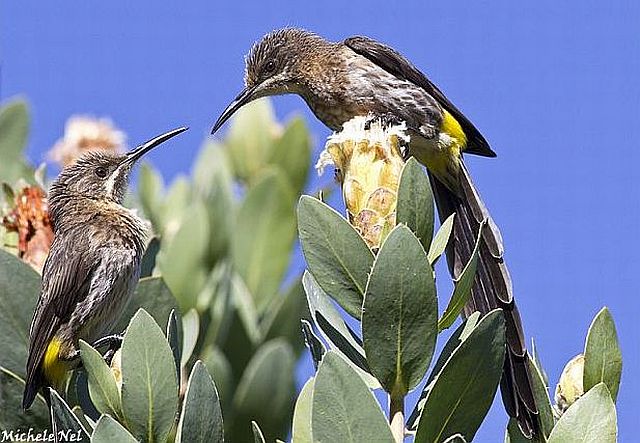 © Michele Nel
© Michele Nel
 © Michele Nel
© Michele Nel
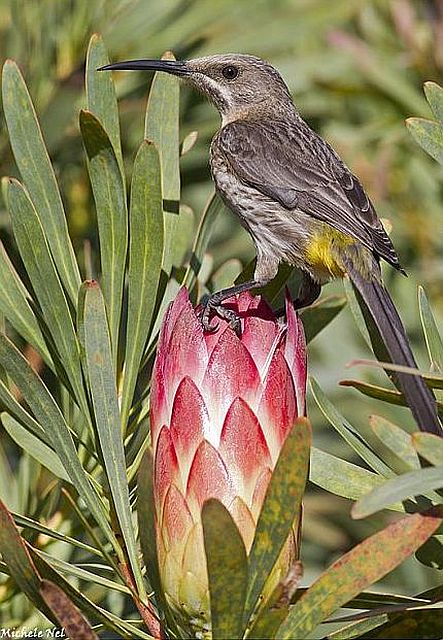 © Michele Nel
© Michele Nel
 Juvenile © Michele Nel
Juvenile © Michele Nel
Links:
Sabap2
Species text Sabap1
Simmons, R. 2009. Sugar rush. Africa - Birds & Birding 14(4):14-15.
 © Michele Nel
© Michele Nel © Michele Nel
© Michele Nel © Michele Nel
© Michele Nel Juvenile © Michele Nel
Juvenile © Michele Nel Links:
Sabap2
Species text Sabap1
Simmons, R. 2009. Sugar rush. Africa - Birds & Birding 14(4):14-15.
Gurney's Sugarbird
774. Gurney's Sugarbird Promerops gurneyi (Rooiborssuikervoël)
Order: Passeriformes. Family: Promeropidae
Description
23-27cm; 35g
Sexes similar. Male is large than the female with a longer tail. Unlikely to be confused with any other species with its distinctive russet breast and forecrown. long tail and yellow undertail coverts. Lacks malar stripes of Cape Sugarbird. Juvenile has a brown breast, brownish yellow undertail and a yellow gape.
Distribution
Endemic to southern Africa, occurring in Zimbabwe's eastern highlands and Limpopo Province extending into Mpumalanga, with a separate population in western KwaZulu-Natal, Lesotho and the far east of the Eastern Cape.

Habitat
Montane habitats with Aloe, Protea and Strelitzia, also occupying Protea farms; its distribution is strongly linked to that of the Silver protea.
Diet
It mainly feeds on nectar (especially of Protea species), supplemented with arthropods gleaned from flowers and hawked aerially; in one study it spent 8% of it foraging time catching prey, increasing to 18% in the breeding season when it feeds arthropods to the chicks.
Breeding
The nest is built solely by the female in about 5-15 days, consisting of a shallow cup made of rootlets, twigs and bark fibres, lined with grass and the brown fluff and seeds of proteas. It is typically placed in a fork, between branches or at the base of an inflorescence with branches below it, usually in Silver protea (Protea roupelliae) but also Common protea (Protea caffra) and cultivated proteas on flower farms.
Call
Rapid high-pitched jumble of twittery and twanging notes.
Status
Uncommon to locally common endemic, sedentary with local altitudinal movements recorded in winter. IUCN status - Not threatened, although destruction of protea-savanna habitats is cause for concern, although it has benefited greatly from protea farming. However control measures might be implemented as it damages the flowers, causing farmers to lose income.
Order: Passeriformes. Family: Promeropidae
Description
23-27cm; 35g
Sexes similar. Male is large than the female with a longer tail. Unlikely to be confused with any other species with its distinctive russet breast and forecrown. long tail and yellow undertail coverts. Lacks malar stripes of Cape Sugarbird. Juvenile has a brown breast, brownish yellow undertail and a yellow gape.
Distribution
Endemic to southern Africa, occurring in Zimbabwe's eastern highlands and Limpopo Province extending into Mpumalanga, with a separate population in western KwaZulu-Natal, Lesotho and the far east of the Eastern Cape.

Habitat
Montane habitats with Aloe, Protea and Strelitzia, also occupying Protea farms; its distribution is strongly linked to that of the Silver protea.
Diet
It mainly feeds on nectar (especially of Protea species), supplemented with arthropods gleaned from flowers and hawked aerially; in one study it spent 8% of it foraging time catching prey, increasing to 18% in the breeding season when it feeds arthropods to the chicks.
Breeding
The nest is built solely by the female in about 5-15 days, consisting of a shallow cup made of rootlets, twigs and bark fibres, lined with grass and the brown fluff and seeds of proteas. It is typically placed in a fork, between branches or at the base of an inflorescence with branches below it, usually in Silver protea (Protea roupelliae) but also Common protea (Protea caffra) and cultivated proteas on flower farms.
Call
Rapid high-pitched jumble of twittery and twanging notes.
Status
Uncommon to locally common endemic, sedentary with local altitudinal movements recorded in winter. IUCN status - Not threatened, although destruction of protea-savanna habitats is cause for concern, although it has benefited greatly from protea farming. However control measures might be implemented as it damages the flowers, causing farmers to lose income.
Gurney's Sugarbird Photos
774. Gurney's Sugarbird Promerops gurneyi (Rooiborssuikervoël)
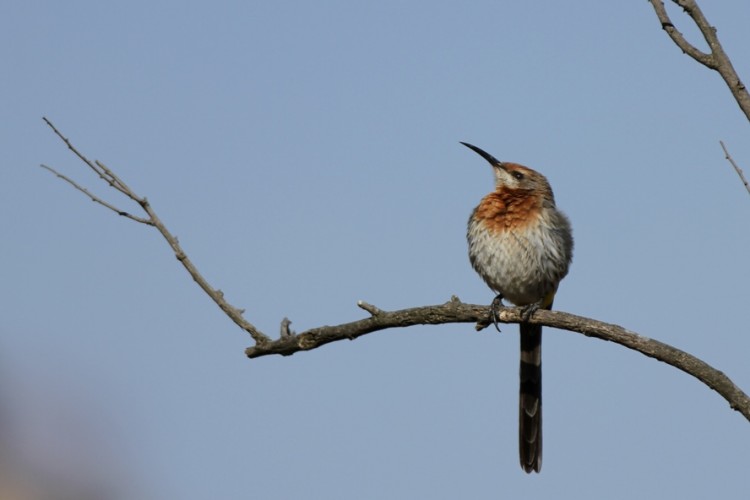 © Dindingwe
© Dindingwe
Giant's Castle, KZN
Links:
http://www.biodiversityexplorer.org/bir ... urneyi.htm
Roberts Bird Guide
 © Dindingwe
© DindingweGiant's Castle, KZN
Links:
http://www.biodiversityexplorer.org/bir ... urneyi.htm
Roberts Bird Guide
Family Sturnidae (Starlings)
Starlings are small to medium-sized passerine birds in the family Sturnidae. Many Asian species, particularly the larger ones, are called mynas, and many African species are known as glossy starlings because of their iridescent plumage.
Starlings are native to the Old World, from Europe, Asia and Africa, to northern Australia and the islands of the tropical Pacific.
Starlings have strong feet, their flight is strong and direct, and they are very gregarious. Their preferred habitat is fairly open country, and they eat insects and fruit. Several species live around human habitation, and are effectively omnivores.
Plumage of many species is typically dark with a metallic sheen. Most species nest in holes, laying blue or white eggs.
Starlings have diverse and complex vocalizations, and have been known to embed sounds from their surroundings into their own calls, including car alarms, and human speech patterns. The birds can recognize particular individuals by their calls.
There is less sexual dimorphism in plumage however, with only 25 species showing such differences between the sexes. The plumage of the starlings is often brightly coloured due to iridescence; this colour is derived from the structure of the feathers, not from any pigment.
African species are found in open woodlands and savannah.
The starlings are generally a highly social family. Most species associate in flocks of varying sizes throughout the year.
Starlings imitate a variety of avian species and have a repertoire of about 15–20 distinct imitations. They also imitate a few sounds other than those of wild birds. The calls of abundant species, calls that are simple in frequency structure and calls that show little amplitude modulation are preferentially imitated.
The diets of the starlings are usually dominated by fruits and insects.
Lamprotornis is a large genus of glossy-starlings all of which occur in Africa south of the Sahara. They have glossy blue or green upper parts, which is due to hollow melanin granules arranged in a single layer near the feather barbule’s surface. The under parts of these species lacks iridescence. They may be blue, purple, yellow or brown. Most Lamprotornis starlings have striking yellow or red irides and some have long tails.
These glossy starlings are found in a variety of habitats from forests to open woodland and gardens. They nest in tree holes, either natural, or made by woodpeckers or barbets, and some will used man-made structures. Most species are resident apart from seasonal or local movement, but Shelley’s Starling is migratory. Most species are gregarious outside the breeding season.
Lamprotornis glossy-starlings are omnivorous and mostly feed on the ground, although they will take fruit from trees. Some will feed on or near large mammals to find insects.
Links:
Africa Wild: STARLINGs & their Allies - Bird of the Month: April 2013
Starlings are native to the Old World, from Europe, Asia and Africa, to northern Australia and the islands of the tropical Pacific.
Starlings have strong feet, their flight is strong and direct, and they are very gregarious. Their preferred habitat is fairly open country, and they eat insects and fruit. Several species live around human habitation, and are effectively omnivores.
Plumage of many species is typically dark with a metallic sheen. Most species nest in holes, laying blue or white eggs.
Starlings have diverse and complex vocalizations, and have been known to embed sounds from their surroundings into their own calls, including car alarms, and human speech patterns. The birds can recognize particular individuals by their calls.
There is less sexual dimorphism in plumage however, with only 25 species showing such differences between the sexes. The plumage of the starlings is often brightly coloured due to iridescence; this colour is derived from the structure of the feathers, not from any pigment.
African species are found in open woodlands and savannah.
The starlings are generally a highly social family. Most species associate in flocks of varying sizes throughout the year.
Starlings imitate a variety of avian species and have a repertoire of about 15–20 distinct imitations. They also imitate a few sounds other than those of wild birds. The calls of abundant species, calls that are simple in frequency structure and calls that show little amplitude modulation are preferentially imitated.
The diets of the starlings are usually dominated by fruits and insects.
Lamprotornis is a large genus of glossy-starlings all of which occur in Africa south of the Sahara. They have glossy blue or green upper parts, which is due to hollow melanin granules arranged in a single layer near the feather barbule’s surface. The under parts of these species lacks iridescence. They may be blue, purple, yellow or brown. Most Lamprotornis starlings have striking yellow or red irides and some have long tails.
These glossy starlings are found in a variety of habitats from forests to open woodland and gardens. They nest in tree holes, either natural, or made by woodpeckers or barbets, and some will used man-made structures. Most species are resident apart from seasonal or local movement, but Shelley’s Starling is migratory. Most species are gregarious outside the breeding season.
Lamprotornis glossy-starlings are omnivorous and mostly feed on the ground, although they will take fruit from trees. Some will feed on or near large mammals to find insects.
Links:
Africa Wild: STARLINGs & their Allies - Bird of the Month: April 2013
Family Sturnidae (Starlings) Index
Family Sturnidae (Starlings)
Acridotheres tristis Common Myna 758
Sturnus vulgaris Common Starling 757
Creatophora cinerea Wattled Starling 760
Notopholia corrusca Black-bellied Starling 768
Lamprotornis nitens Cape Starling 764
Lamprotornis chalybaeus Greater Blue-eared Starling 765
Lamprotornis chloropterus Lesser Blue-eared Starling
Lamprotornis elisabeth Miombo Blue-eared Starling 766
Lamprotornis mevesii Meves's Starling 763
Lamprotornis australis Burchell's Starling 762
Lamprotornis acuticaudus Sharp-tailed Starling 767
Lamprotornis bicolor Pied Starling 759
Cinnyricinclus leucogaster Violet-backed Starling 761
Onychognathus morio Red-winged Starling 769
Onychognathus nabouroup Pale-winged Starling 770
Acridotheres tristis Common Myna 758
Sturnus vulgaris Common Starling 757
Creatophora cinerea Wattled Starling 760
Notopholia corrusca Black-bellied Starling 768
Lamprotornis nitens Cape Starling 764
Lamprotornis chalybaeus Greater Blue-eared Starling 765
Lamprotornis chloropterus Lesser Blue-eared Starling
Lamprotornis elisabeth Miombo Blue-eared Starling 766
Lamprotornis mevesii Meves's Starling 763
Lamprotornis australis Burchell's Starling 762
Lamprotornis acuticaudus Sharp-tailed Starling 767
Lamprotornis bicolor Pied Starling 759
Cinnyricinclus leucogaster Violet-backed Starling 761
Onychognathus morio Red-winged Starling 769
Onychognathus nabouroup Pale-winged Starling 770
- Flutterby
- Posts: 44029
- Joined: Sat May 19, 2012 12:28 pm
- Country: South Africa
- Location: Gauteng, South Africa
- Contact:
Common Myna
758. Common Myna (Indian Myna) Acridotheres tristis (Indiese Spreeu)
Order: Passeriformes. Family: Sturnidae
Description
25 cm. A fairly large, stocky Myna. Brownish plumage. Black hood. Bare yellow eye-patch. Very short frontal crest. Dark brown wings, in flight large white wing-patches conspicuous. White vent and centre of belly. Yellow legs and bill. Sexes similar.
Juveniles are duller and browner.
Distribution
Originally from India, central and southern Asia, it was introduced to many islands in the Pacific and Atlantic, Australia, New Zealand, Hong Kong, Brunei, Sumatra and South Africa. Here it is locally abundant in KwaZulu-Natal, Mpumalanga and the eastern Free State, marginally extending into the North-West Province and the Eastern Cape. Common mynahs were originally introduced into Natal in an effort to control cane beetles, garden insects and locusts. The birds breed extremely rapidly and compete with other birds for food resources and nesting space. Listed as an invasive alien species.
Habitat
It generally prefers urban areas and farms in the immediate vicinity of buildings and other structures.
Diet
It mainly eats a invertebrates, fruit and seeds, doing most of its foraging on the ground, briskly walking around and probing the soil.
Breeding
The nest is built by both sexes, consisting of an untidy structure made of grass, twigs, hair and man-made materials, such as paper, cloth, string and plastic pieces. It is typically placed in a building, more rarely in a free-standing tree or a cavity in a branch. Egg-laying season is year-round, peaking from September-January. It lays 2-6 eggs, which are incubated by both sexes for about 13-18 days. The chicks are fed by both parents, leaving the nest after about 22-35 days, becoming fully independent several weeks later.
Call
Unmusical squawks, whistles and croaks, including mimicry. Listen to Bird Call.
Status
Very common or abundant resident.
Order: Passeriformes. Family: Sturnidae
Description
25 cm. A fairly large, stocky Myna. Brownish plumage. Black hood. Bare yellow eye-patch. Very short frontal crest. Dark brown wings, in flight large white wing-patches conspicuous. White vent and centre of belly. Yellow legs and bill. Sexes similar.
Juveniles are duller and browner.
Distribution
Originally from India, central and southern Asia, it was introduced to many islands in the Pacific and Atlantic, Australia, New Zealand, Hong Kong, Brunei, Sumatra and South Africa. Here it is locally abundant in KwaZulu-Natal, Mpumalanga and the eastern Free State, marginally extending into the North-West Province and the Eastern Cape. Common mynahs were originally introduced into Natal in an effort to control cane beetles, garden insects and locusts. The birds breed extremely rapidly and compete with other birds for food resources and nesting space. Listed as an invasive alien species.
Habitat
It generally prefers urban areas and farms in the immediate vicinity of buildings and other structures.
Diet
It mainly eats a invertebrates, fruit and seeds, doing most of its foraging on the ground, briskly walking around and probing the soil.
Breeding
The nest is built by both sexes, consisting of an untidy structure made of grass, twigs, hair and man-made materials, such as paper, cloth, string and plastic pieces. It is typically placed in a building, more rarely in a free-standing tree or a cavity in a branch. Egg-laying season is year-round, peaking from September-January. It lays 2-6 eggs, which are incubated by both sexes for about 13-18 days. The chicks are fed by both parents, leaving the nest after about 22-35 days, becoming fully independent several weeks later.
Call
Unmusical squawks, whistles and croaks, including mimicry. Listen to Bird Call.
Status
Very common or abundant resident.
- Flutterby
- Posts: 44029
- Joined: Sat May 19, 2012 12:28 pm
- Country: South Africa
- Location: Gauteng, South Africa
- Contact:
Common Myna Photos
758. Common Myna Acridotheres tristis (Indiese Spreeu)
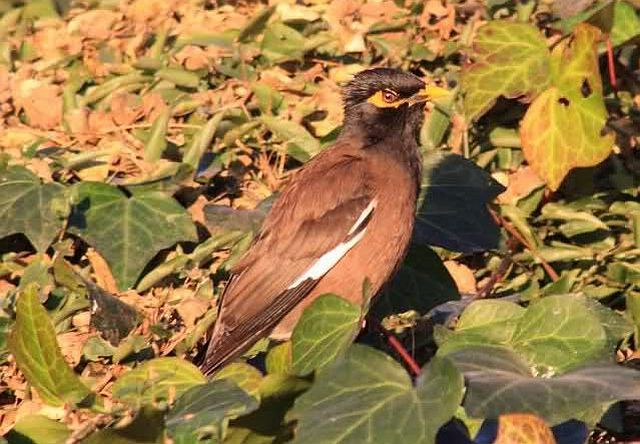
 © leachy
© leachy
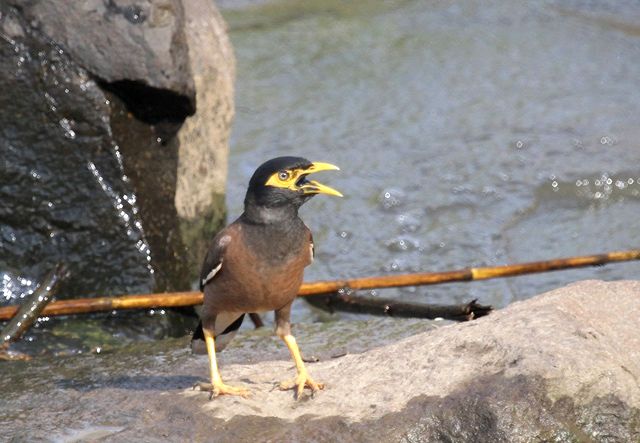 © leachy
© leachy
Links:
Species text Sabap1
Sabap2: http://sabap2.adu.org.za/spp_summary.ph ... §ion=3
Oiseaux net
Ian Sinclair. SASOL VOELS VAN SUIDER AFRICA (3de UIT)

 © leachy
© leachy © leachy
© leachyLinks:
Species text Sabap1
Sabap2: http://sabap2.adu.org.za/spp_summary.ph ... §ion=3
Oiseaux net
Ian Sinclair. SASOL VOELS VAN SUIDER AFRICA (3de UIT)


